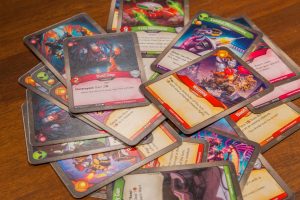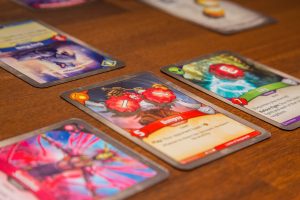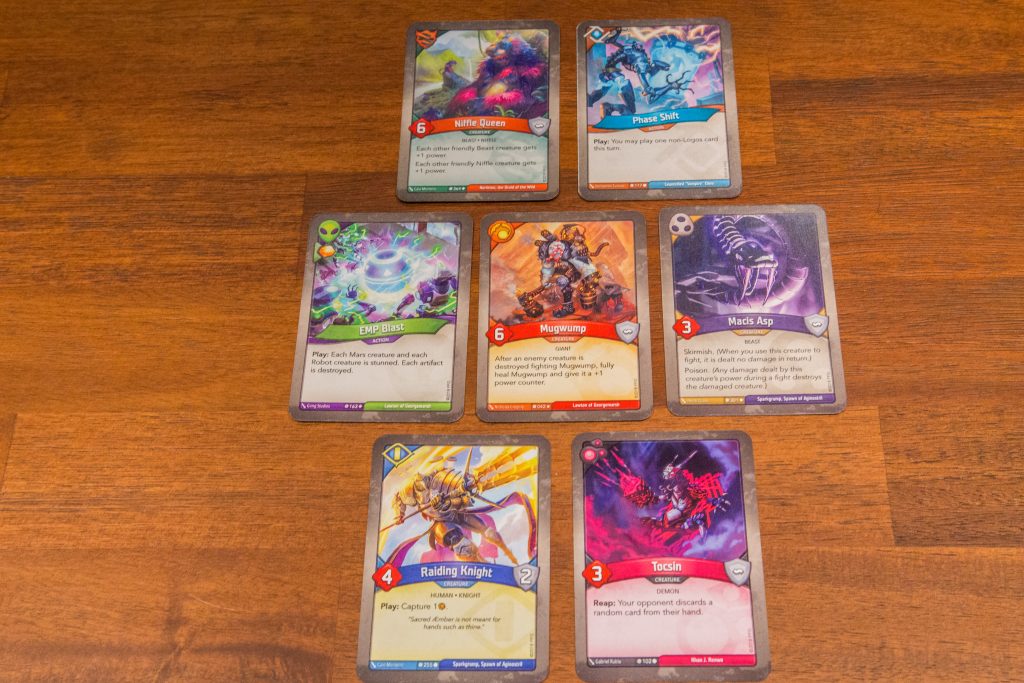 If you’re a fan of Trading Card Games, you’ll know that they aren’t cheap. I don’t even want to know how much money I spent on Magic: the Gathering over the years. If you don’t spend enough money on these games or don’t have absurd amounts of luck opening packs, you’ll likely fall behind the competitive scene pretty quickly, if that’s your thing. Enter: KeyForge, from the mind of Richard Garfield, the man behind Magic: the Gathering! Published by Fantasy Flight Games, Call of the Archons is the first of several KeyForge sets.
If you’re a fan of Trading Card Games, you’ll know that they aren’t cheap. I don’t even want to know how much money I spent on Magic: the Gathering over the years. If you don’t spend enough money on these games or don’t have absurd amounts of luck opening packs, you’ll likely fall behind the competitive scene pretty quickly, if that’s your thing. Enter: KeyForge, from the mind of Richard Garfield, the man behind Magic: the Gathering! Published by Fantasy Flight Games, Call of the Archons is the first of several KeyForge sets.
KeyForge features a very unique mechanic: there is no deck-building, because this is the first ever Unique Deck Game. That’s right: no booster packs, no theorycrafting, no net-decking. Every deck you buy will be 100%, completely unique from any other deck in the world. There are 104 QUADRILLION possible combinations of decks, in fact! Therefore, all you really need to jump into KeyForge is 10-15 dollars, enough to purchase a single deck. The gameplay itself features several familiar card game mechanics, but with satisfying twists and changes that keep things feeling fresh and new. This is an exciting new game that I’m coming back to daily, always wanting to play just one more game.

There are endless possibilities in KeyForge. Literally.
ARTWORK AND COMPONENTS
KeyForge has a very distinct style in its card art and I loved opening new decks, not only to see which new cards I would discover, but also to see all the new art as well. Each house has a very distinct look and feel from each other house, which I appreciated. If someone only showed me the artwork for a card, I could probably tell you exactly which house it belonged to. Since each deck comes with three different houses, this means you’ll have solid variety in each deck as well.
KeyForge also doesn’t take itself too seriously. Whereas Magic has a much more intense and serious tone to its cards and artwork, KeyForge definitely welcomes more tongue-in-cheek humour in both the card art and the card names. Card names like Martians Make Bad Allies are commonplace in KeyForge and this kind of humor and character makes it more similar to Hearthstone in terms of flavour.
Also worth mentioning is that the card back art is unique for every single deck. Each deck features a unique looking Archon in a variety of colours, giving your deck another way to feel completely and totally yours.
As for components, there isn’t much to mention in a regular single deck box. The cards are what you expect from any card game. You also receive a handy deck list card that features a QR code that allows you to register your deck online or via the app for bonus functionality through Fantasy Flight Games. Speaking of which, this website and app, called the KeyForge Master Vault, is a great, if fairly basic, tool that allows you to track all decks you’ve discovered, your wins and losses in the competitive scene and any chains your deck has acquired as well. There isn’t a whole lot to it, but there is tons of potential and Fantasy Flight has plans to expand and add to it in the future.
There is also a starter set for Call of the Archons that comes with 2 unique decks, 2 starter decks and a slew of tokens that makes tracking all the various items in KeyForge much easier. You can check out our thoughts on that here.
DESIGN
The big draw here is the unique deck system. Every deck is unique, every deck is played differently and every deck is a new opportunity to learn strategies and explore the world of this card game. This is the promise being made by Richard Garfield and Fantasy Flight Games, but is it all true? The answer is, surprisingly, yes. In all my time playing KeyForge, I’ve found that the fun of this game derives from having to learn each new deck; its strengths and weaknesses, its combos, its nuances, and then bring those discoveries into the games you play in an attempt to try and make the deck work. It’s an incredibly clever and brilliant concept that works very well. Every time I buy or play with a new deck, I feel like I’m discovering the game all over again. Every deck feels like playing KeyForge for the first time in some way, whether it’s because of a different combination of houses, or because the cards in the deck demand to be played with a completely different thought process.

Every deck will give you a random combination of three out of seven houses and then a mostly random assortment of cards from them. I say mostly random because there are certain restrictions that seem to be at play after getting our hands-on data that has become widely available on the KeyForge subreddit and other sites. For instance, decks don’t seem to have fewer than 10 creatures or more than 28. These restrictions are likely in place to make sure you don’t receive a deck that is completely unplayable, overpowered or awful. In my experience so far, the algorithms at play work surprisingly well. There are a few instances of “dead cards” showing up in decks or cards meant to be part of a combo being present without the other combo pieces, but overall, every deck has something interesting to discover. Any losses with the decks draw me in as a sort of challenge to see if I can make them work or to figure out what strategies I need to employ. Unfortunately, one downside with this system is that it is possible that when purchasing a new deck, you could end up with a combination of houses you already have or a similar deck makeup or strategy to one you already own. While not overly common, I have gone to purchase a new deck, excited about the possibilities for a fresh take on KeyForge, only to find I ended up with something that plays very similarly to one I already own. Since decks are locked in, there isn’t much you can do at that point. Thankfully, in general, you’ll usually find something new and fresh with each deck you buy.
The unique aspect of KeyForge also applies to the seven houses. For example, Shadows plays vastly different than Mars, while Brobnar plays vastly different than Logos. The houses all share aspects with other houses as well, however, which makes potential synergies and compatibilities in decks exciting when you get the right mixture. While I definitely have my favourites among the houses, all of them have been fun to play and I don’t feel that any house in particular is being completely outclassed, at least not in my experience. While I’ve certainly played with decks that, for instance, have a very weak Mars presence or a very uninspired Dis presence, this is really a deck recipe issue, more than it is an issue about the house itself. I have other decks that have extremely powerful, synergistic and fun Mars and Dis components as well.
Despite the unique and exciting deck system, it would be for naught if the gameplay mechanics weren’t solid. Thankfully, this is one area Richard Garfield rarely disappoints and he delivers yet again with KeyForge. Gone are the days of hoping to draw and play enough mana to play your most powerful cards. KeyForge handles its unique card playing system elegantly and cleverly. Figuring out the best way to spend my turn is always a ton of fun. The strategy and nuances come from situations where you have to juggle the many different things you want to do on your turn across the three houses in your deck. You’ll often encounter situations where you have four or five solid cards from Sanctum, for example, but a board full of Brobnar creatures. Do you utilize the creatures to reap æmber and put pressure on your opponent to stop you? Or do you play a slew of Sanctum actions to clear your opponent’s board or stop them from gaining æmber themselves? These are the questions you’ll ask yourself frequently in KeyForge, and getting better at the game usually means being better at analyzing these situations and finding the path to victory. It’s a tremendously simple mechanic in theory, but in practice, it’s what makes KeyForge so much fun to play and so strategic at the same time.
Every time I buy or play with a new deck, I feel like I’m discovering the game all over again.
One thing that did catch me a bit off guard was how long the games in KeyForge can take. Being used to several other card games, I was expecting games to take, on average, somewhere between 15-20 minutes to finish. In reality, I’ve had most of my games of KeyForge take 30-45 minutes to finish, sometimes longer. The game is still relatively new and I, along with many others, are still learning as well, but KeyForge seems like it will have longer games than many may be used to. That’s not necessarily a bad thing, it’s a fun experience the whole way through and it’s only when the game is done that I’m realizing how long I’ve been playing for. From a competitive play standpoint, it would be a shame to have several matches end in tie-breaker scenarios because of stores trying to keep tournament length down. Obviously this remains to be seen, but it’s something worth noting for the time being.
FUN FACTOR
While KeyForge makes bold departures from mechanics and systems we’ve come to expect in card games, it wouldn’t mean anything if the game wasn’t fun. Thankfully, it’s a blast. I’m constantly coming back to it and looking for new opportunities to throw down a few games. Another interesting departure, in KeyForge you aren’t actually trying to kill your opponent, rather you’re attempting to be the first one to forge the three keys needed to open the Archon Vault. Essentially, a game of KeyForge is a race and it definitely feels that way as you play. One of the first things I had to adjust to was the fact that I didn’t necessarily have to clear my opponent’s board of creatures. Ultimately, your opponent will be utilizing these creatures to reap æmber and get closer to victory, but because of being restricted to a single house, there are several scenarios where it’s just as lucrative for you to ignore your opponent’s board and put the pressure on them by forging keys instead. KeyForge, therefore, tends to balance applying pressure to your opponent in order to force them to block you or prevent you from forging keys, and controlling your opponent to prevent them from doing the same. It’s a tug of war that plays beautifully and victory in KeyForge matches always feels like it’s in reach. Blowouts will happen, but they feel fewer and further between than other card games I’ve played.
It’s interesting just how impactful the house restriction mechanic feels. I’ve played games where I’ve had six or seven creatures on my board and had this illusion of completely overrunning my opponent, and then on my next turn I realize that if I choose one house, I’ll be able to use five of those creatures to reap æmber and perform abilities, but will also be able to play literally nothing from my hand. Or I could choose a different house and make a ton of moves from my hand, which will allow me to draw into other powerful and useful cards, but the sacrifice will be only using a single creature to reap æmber. This catch-22 is the core of KeyForge, and the way it makes you think about situations and strategies is incredibly fun.

There is a lot of variety between houses, both in play style and artwork.
Another thing KeyForge has going for it is that losing a game, even by a wide margin, never feels quite as bad to me as it sometimes does in other card games. In a game like Magic or Hearthstone, losing a game especially poorly would often make me consider new deck-building options or trigger a “back to the drawing board” response. The fascinating thing about KeyForge is my response to a loss is different. Instead of feeling bad about it, I only want to get better at playing my specific deck and continue to work towards figuring out its nuances. Maybe I’m playing this particular deck too conservatively or too aggressively. Maybe I need to reap with my creatures more often. Maybe I need to save some of my big actions for the right moment and create “swing turns”. It all really comes down to the deck you opened and while I can completely understand this being a turnoff for some people, it feels like an intriguing challenge I want to constantly overcome.
All that being said, it is still important to note that there are some things KeyForge misses out on by not having a deck-building mechanic. For a lot people, myself included, there’s a lot of fun to be had from delving into your collection of cards and piecing things together, trying to make things work, or trying to craft around the perfect combo. None of that is present here, because what you open is what you get. If you open a particularly challenging or uninteresting deck, you don’t really have an option to deconstruct it or try something else. Ultimately though, I think this is mainly going to be more of an issue if you approach KeyForge in the same way you would approach other popular deck-building games. This is a whole new type of card game and what it lacks in deck-building, I feel like it makes up for in deck strategy and deck-learning, especially when people can’t rely on going online and searching out the most influential and best performing decks.
VALUE
As a value product, it’s hard to fault KeyForge. Here’s a game that you can start playing for 10-15 dollars, and depending how much you enjoy the first deck you buy, you can potentially get a lot of mileage out of such a small purchase. There’s no pressure to spend a whole bunch of money buying a bunch of singles to make your deck better. Granted, there’s a definite pull with KeyForge and I constantly want to buy new decks to see what interesting combinations, cards and strategies I’ll find. But at the end of the day, even a couple decks can last you a long time and it doesn’t demand much of an investment overall.
As for the game itself, I’ve yet to grow bored of KeyForge and I’m constantly looking forward to the next game I play. Every game feels a little bit different from the last one and each game is a test of my ability to make this unique deck work. Games are also vastly different depending on what deck you’re playing – with and against – and since there are endless possibilities out there, there really are endless matchup possibilities as well. This gives KeyForge some really good lasting appeal.
KeyForge is a tremendous achievement and a refreshing product.
Finally, it’s worth mentioning that KeyForge is evolving over time. There have already been two new sets, with more on the horizon, and this trend will no doubt continue as long as the game is successful. This only adds to the longevity even more. All decks from previous sets remain relevant and playable indefinitely or for the foreseeable future at least, meaning there’s no need to ditch all your current content when a new expansion is released. It’s hard not to be excited about the possibilities and the potential.
FINAL THOUGHTS
KeyForge is a tremendous achievement and a refreshing product. It changes the way you think about a card game and really puts your strategic thinking to the test. The unique deck system provides a very low barrier for entry and makes every new deck a puzzle that you need to figure out. How will I make this deck work? How will I play against this deck? Or this one? What combos are in this deck? What is my win condition? What kind of game should I be playing? These are all questions you’ll ask yourself just on a first glance of your deck and it only gets better when you put it to the test.
The gameplay mechanics are also very unique, albeit still familiar at times if you’ve played other card games, but the house system makes for some great catch-22 thinking and allows for a lot of fun and interesting strategy.
It’s not perfect. Games can sometimes be overly long, and lack of deck-building means that if you don’t like a deck you open, your options are more limited than other TCGs on the market. But as a new way to think about and play a card game, it’s a fantastic experience. Keyforge exceeded all my expectations for it and everyone I have introduced this game to has latched on and ended up purchasing multiple decks, tumbling headfirst into its rich, addicting and tremendously entertaining world.
Pros
- Gameplay is fun, strategic and often different each game, making for an addicting experience.
- Endless possibilities for decks.
- Restricting each turn to a single house is strategic and makes for fun decisions.
Cons
- Games tend to be slightly on the long side.
- Although not very common, opening up a deck similar to one you already own can be disappointing.
- If you need deck-building, this isn't the TCG for you.
2 comments
Leave a reply
You must be logged in to post a comment.







Wow! So thorough and insightful! This site is sweet!
Thanks a lot, Aaron! Appreciate that.